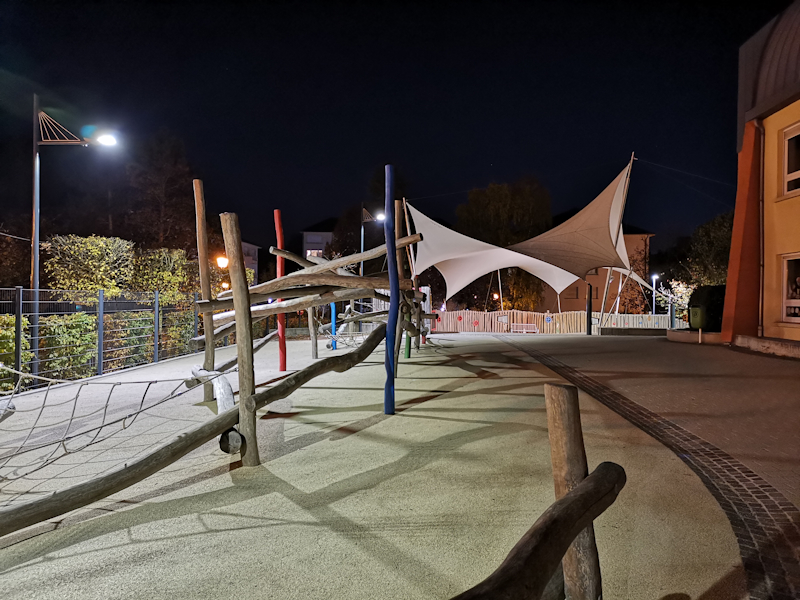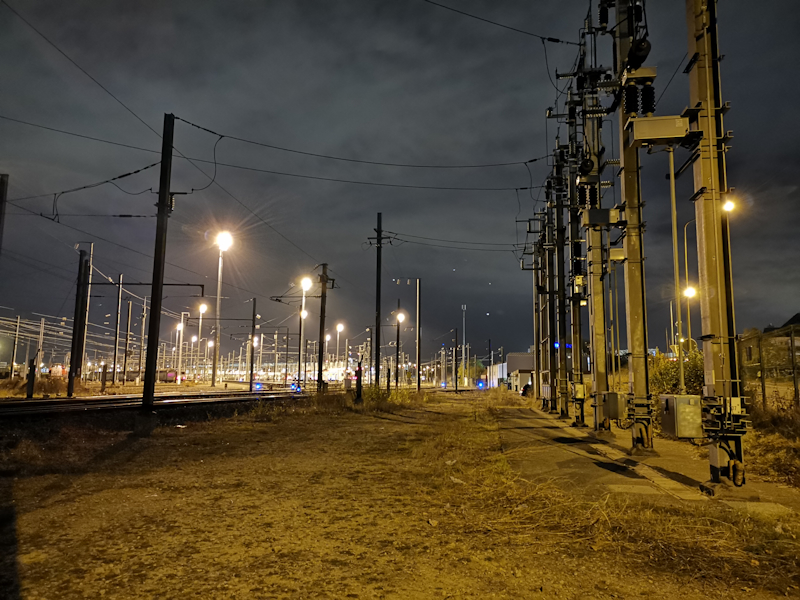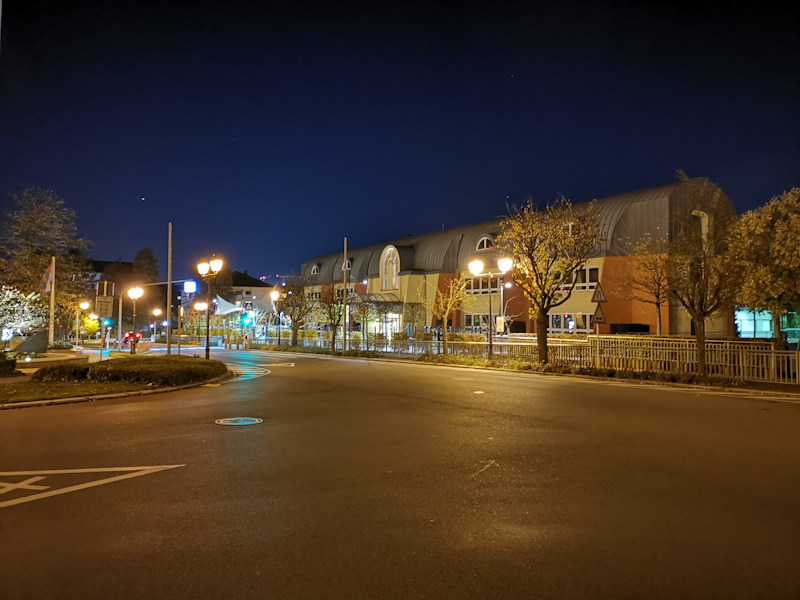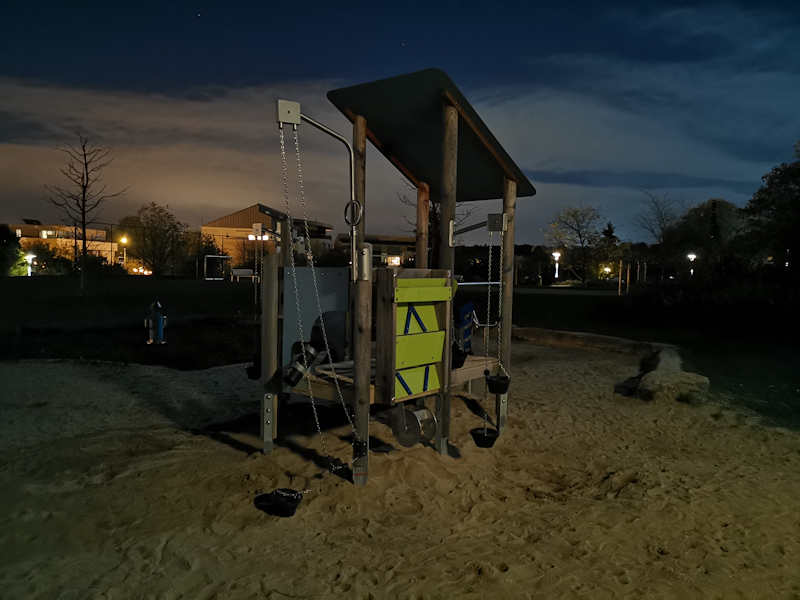The Mate 20 & Mate 20 Pro Review: Kirin 980 Powering Two Contrasting Devices
by Andrei Frumusanu on November 16, 2018 8:10 AM EST- Posted in
- Smartphones
- Huawei
- Mobile
- Kirin 980
- Mate 20
- Mate 20 Pro
Camera - Low Light Evaluation - Night Sight
Low-light capture was a forte for Huawei this year, as they were the first to introduce a low-light mode that was able to capture vastly superior exposure shots without having to use a tripod. The results on the P20’s were excellent, so let’s see how the new Mate 20’s fare.
[ Mate 20Pro ] - [ Mate 20 ] - [ P20Pro ]
[ P20 ] - [ Mate 10Pro ] - [ Pixel 3 ] - [ Pixel 2 ]
[ Pixel XL ] - [ iPhone XS ] - [ iPhone X ] - [ Note9 ] - [ S9+ ] - [ S8 ]
[ LG G7 ] - [ LG V30 ] - [ OnePlus 6 ] - [ OPPO FindX ] - [ MIX2S ]
In the first scene, the Mate 20 Pro goes off to a bad start as noted focus issues when capturing the scene. Here the phone multiple times took out of focus captures, with none of my night mode shots actually ending up in focus. In the regular mode, the Mate 20 Pro’s camera switches over to its unique high ISO mode and is able to deliver great results at ISO25600. We have to remember that the phones don’t actually have OIS, so again like on the P20 Pro this is quite remarkable. Also a big change compared to the P20 Pro is the colour rendition, here the Mate 20 Pro is able to extract much better colours out of the scene, and all while reducing noise significantly.
The Mate 20’s regular mode isn’t all that impressive as pretty much in line with how most sensors behave in low light. Here turning on Night mode is a requirement, and greatly improves the picture quality.
Google’s new Night Sight mode outmatches Huawei’s phones in terms of light capture, noise and detail retention, however the images is so bright that it’s less natural than the Mate’s results.
[ Mate 20Pro ] - [ Mate 20 ] - [ P20Pro ] - [ P20 ]
[ Mate 10Pro ] - [ Pixel 3 ] - [ Pixel 2 ] - [ Pixel XL ]
[ iPhone XS ] - [ iPhone X ] - [ Note9 ] - [ S9+ ] - [ S8 ]
[ LG G7 ] - [ LG V30 ] - [ OnePlus 6 ] - [ OPPO FindX ] - [ MIX2S ]
The second scene the Mate 20 Pro does a very different exposure to the P20 Pro, the latter did a much more accurate representation of the brightness and colour temperature of the sodium street lamps. Turning on night mode improved things a lot for both phones.
Overall the Mate 20’s are among the best low light shooters thanks to night mode, only recently dethroned by Google’s Pixel phones.
[ Mate 20Pro ] - [ Mate 20 ] - [ P20 ]
[ Mate 10Pro ] - [ Pixel 3 ] - [ Pixel 2 ] - [ Pixel XL ]
[ iPhone XS ] - [ iPhone X ] - [ Note9 ] [ S9+ ] - [ S8 ]
[ LG V30 ] - [ OnePlus 6 ] - [ OPPO FindX ]
The next scene the Mate 20 Pro varies in its results while in auto mode. The first shot has better dynamic range and also better detail retention, here Huawei needs a way to keep things more consistent. The regular mode on the Mate 20 is also good, although it’s lacking in texture detail as well showing some very weird blur in the right part of the image. Here I think the lack of OIS is hampering the phones.
Turning on night mode again improves the quality, but again the regular Mate 20 is giving out some blurred results here as its multi-frame stacking doesn’t seem to work correctly.
I would say the Mate 20 Pro along with the Pixel’s Night Sight modes are leading closely together.
[ Mate 20Pro ] - [ Mate 20 ] - [ P20Pro ] - [ P20 ]
[ Mate 10Pro ] - [ Pixel 3 ] - [ Pixel 2 ] - [ Pixel XL ]
[ iPhone XS ] - [ iPhone X ] - [ Note9 ] - [ S9+ ] - [ S8 ]
[ LG G7 ] - [ LG V30 ] - [ OnePlus 6 ] - [ OPPO FindX ] - [ MIX2S ]
Partial blurriness is again an issue of the Mate 20 in this scene. The Mate 20 Pro doesn’t have any issue in this regard, and captures the best regular mode shot among all phones.
Switching to night mode, it brightens up things for both units, and also resolves the blurriness issue on the Mate 20. Although Huawei’s phones are showcasing more realistic exposures, the Pixel phones night mode outclass them in terms of detail retention.
[ Mate 20Pro ] - [ Mate 20 ] - [ P20Pro ] - [ P20 ]
[ Mate 10Pro ] - [ Pixel 3 ] - [ Pixel 2 ] - [ Pixel XL ]
[ iPhone XS ] - [ iPhone X ] - [ Note9 ] - [ S9+ ] - [ S8 ]
[ LG G7 ] - [ LG V30 ] - [ OnePlus 6 ] - [ OPPO FindX ] - [ MIX2S ]
This scene again showcases some big blur issues on the regular Mate 20’s auto shots that are only resolved by turning on night mode. The Mate 20 Pro’s auto mode here produces the most natural result out of all phones.
In night mode, things brighten up a bunch, and Huawei manages much better results than other devices, but is yet again beat by Google’s new software.
Extreme low-light
Extreme low light scenarios is something as early as last year we wouldn’t have expected phones to be viable in. Again I started shooting such scenes earlier in the year when Huawei made its Night mode usable without a tripod – along with vendors like LG introducing pixel binning modes that quadruple the light capture of the sensors.
[ Mate 20Pro ] - [ Mate 20 ] - [ P20Pro ] - [ P20 ]
[ Mate 10Pro ] - [ Pixel 3 ] - [ Pixel 2 ] - [ Pixel XL ]
[ iPhone XS ] - [ iPhone X ] [ Note9 ] - [ S9+ ] - [ S8 ]
[ LG G7 ] - [ LG V30 ] - [ OnePlus 6 ] - [ OPPO FindX ] - [ MIX2S ]
In extreme low light scenarios, the Huawei phones were in a league of their own until just very recently. The Mate 20 Pro in its regular mode relies on ISO25600 to achieve a very good shot, beating all other phones including the P20Pro. The Mate 20 doesn’t fare as well here as its sensor just can’t capture enough light.
In night mode, the Mate 20 Pro gains in sharpness and sheds some of the noise, and the Mate 20 now manages to sufficiently light up the scene, although sharpness and detail aren’t too good. Although the Huawei again have a better natural reproduction of the light in the scene, Google’s night sight just produces a just ridiculously brighter scene that offers significantly better details.
[ Mate 20Pro ] - [ Mate 20 ] - [ P20Pro ] - [ Mate 10Pro ]
[ Pixel 3 ] - [ Pixel 2 ] - [ Pixel XL ]
[ iPhone XS ] - [ iPhone X ] - [ Note9 ] - [ S9+ ] - [ S8 ]
[ LG G7 ] - [ LG V30 ] - [ OnePlus 6 ] - [ OPPO FindX ] - [ MIX2S ]
Finally, in the darkest possible conditions, in a path under the light of the moon, the Mate 20 Pro and P20 Pro are the only camera sensors able to capture anything, with the Mate 20 Pro using its maximum ISO102400 mode. The Mate 20 largely remains blind. Night mode on the Mate 20 Pro actually regresses things in these conditions, while on the Mate 20 it allows to finally make out some parts of the scene.
Again both phones are beat by Google’s new night sight, achieving some pretty astounding results.
Low-light conclusion
Overall in low light conditions, the Mate 20 Pro is a clear leader in terms of its hardware capabilities. Just like on the P20 Pro, the massive sensor as well as is high ISO capabilities prove very beneficial for the phone.
The Mate 20 fared less well in regular mode, and underperforms most other flagships. Here the use of night mode is a requirement to get better shots out of the phone.
Up until recently this would have been the end of my conclusion, but the recent introduction of Google’s new night sight mode means that Huawei no longer is the best in low-light conditions. While I do feel that Google is overdoing it a bit and Huawei still produces the more realistic and representative exposures, the Pixel phones just have a tremendous detail and noise reduction advantage. Still, this is not to take away from Huawei’s great low-light performances, as it still stands above that of many other devices.

















141 Comments
View All Comments
name99 - Friday, November 16, 2018 - link
Please don't treat me like a child; read my comments and treat me accordingly.DDR as a rate (transactions) DOUBLE the clock was only relevant to the transition from SDR to DDR.
What do you think is the difference between DDR and DDR2, or DDDR2 and DDR3, or DDR3 and DDR4?
Part of the problem seems to be that no-one can agree on what "clock" actually refers to.
There are at least two clocks of interest - the internal DRM clock, and the external bus clock.
As far as I can tell:
- DDR doubled the transfer rate over the external bus. (External bus, internal clock the same, just like SDR). Internal clock is ~100..200MHz
- DDR2 runs the external clock at twice the internal clock.
- DDR3 runs the external clock at 4x the internal clock. (still running from ~100 to 266MHz)
- At DDR4 I'm no longer sure (which is part of the whole reason for this confusion).
The obvious assumption is that the external clock is now run at 8x the internal clock; but that does NOT seem to be the case. Rather what's defined as the internal clock is now run twice as fast, so that the internal:external multiplier is still 8x, but the internal clock speeds now range from ~200 to ~400MHz.
Meanwhile, is LPDDR following the same pattern at each generation? I haven't a clue, and can find no useful answer on the internet.
anonomouse - Friday, November 16, 2018 - link
I think the discussion of internal/external clock ratios is somewhat orthogonal to your originally posed question: the clock that is being advertised is the IO clock for the LPDDR4 modules, since they're telling you what the peak bandwidth of the module is. Commands are on the same clock but SDR instead of DDR and each command takes multiple cycles. Don't quite see what is so confusing about the 2133MHz clock though, since the way they are describing it is entirely accurate and is no different from previous practices. DDR4-3200 has a 1600MHz IO clock too.Also worth remembering that while pin speed is higher, individual LPDDR4 channels are 16bits vs 64bits, so it's not like the actual bandwidth is necessarily higher. This phone has 4-channels to get 34.1GB/s, which is the same bandwidth you'd get from a 2-channel DDR4-2133 system, but much more feasible to scale up capacity/channels/clocks on DDR4.
frostyfiredude - Saturday, November 17, 2018 - link
Look, I have no idea where you're going with all the internal clocks and DDR4, DDR3, etc differences so I'm not commenting. But, here are the facts on the Mate 20 Pro:The DRAM - Memory controller interface is clocked at 2133Mhz.
Due to being of the DDR family, 2 bits are transferred per clock.
Together, this mean 4266Mbits/s transfer rate per pin.
Finally its a 64-bit bus, meaning 64 data pins. 273024Mbits/s aggregate bandwidth.
That breaks down to 34.1GB/s.
In standard DIMM form on your favourite PC parts store, this is advertised as DDR4-4266 or PC4-34100.
ternnence - Friday, November 16, 2018 - link
closer from ram to cpu core, higher frequency ram could get. HBM is another example.eastcoast_pete - Friday, November 16, 2018 - link
@Andrei: thanks for this in-depth review! I wonder how S.LSI takes your pessimistic take on their M4; it seems they have a hard time backing away from their in-house design that doesn't seem to cut it. Also, I appreciate that you're live-updating the review with additional information; I trust reviews that add and update their findings as new data become available much more than the one-and-done style.Question: Did you have a chance to ask Huawei along those lines: "What is your commitment to OS updates, how quickly will you make them available, and for how many years?". Having been burned by Huawei a few years ago (promised OS update never arrived), I am still a bit once burned, twice shy. These devices are pricey, and if Huawei wants to take on Apple at Apple prices, they should mirror Apple's commitment to provide OS updates for several years.
rayhydro - Friday, November 16, 2018 - link
I'm using the mate 20 now, and I can confirm it has the same stereo setup as the mate20pro. maybe your unit's top tweeter is faulty ?rayhydro - Friday, November 16, 2018 - link
I tested both side by side in the stores, both model's stereo speakers sound pretty much the same or extremely similar to my ears. I opted for mate 20 due to it's smaller notch and headphone jack :Dlucam - Friday, November 16, 2018 - link
I still think Mali GPU is a garbage GPULolimaster - Friday, November 16, 2018 - link
To put it simply, at the same year, they're 1 year behind.Mali G76 MP10 ~ Adreno 540 (a bit faster on the mali side, maybe)
lucam - Saturday, November 17, 2018 - link
Adreno is always been better. Still think Imagination has the best solution tho